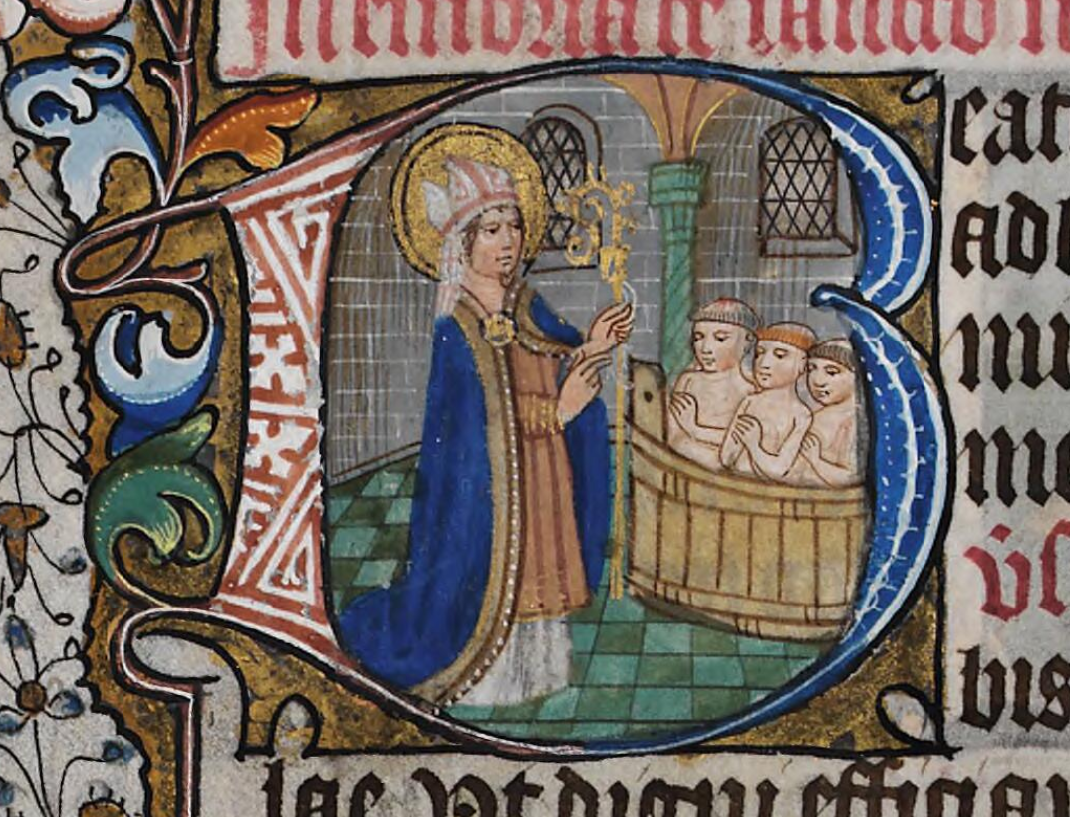Text is from Wikipedia - the free encyclopædia,
unless stated otherwise.
holding a Monstrance containing The Blessed Sacrament.
Photo: 2 July 2007.
Source: Own work.
Attribution: I, Carolus
Author: Carolus
(Wikimedia Commons)
“Ave Verum Corpus”.
Composer: Mozart.
Concierto celebrado en Abril de 1990
en la Iglesia de Waldsassen de Alemania.
Conductor: Leonard Bernstein.
Sung by: Chor und Symphonieorchester
des Bayerischen Rundfunks.
Available on YouTube at
“Tantum Ergo”.
Available on YouTube at
Benediction of The Blessed Sacrament, also called Benediction with The Blessed Sacrament, or, The Rite of Eucharistic Exposition and Benediction, is a Devotional Ceremony, Celebrated especially in The Roman Catholic Church, but also in some other Christian Traditions, such as Anglo-Catholicism, whereby a Bishop, Priest, or a Deacon, Blesses the Congregation with The Eucharist at the end of a period of Adoration.
The actual Benediction, or Blessing, follows Exposition of The Blessed Sacrament, i.e., the placing of the Consecrated Host in a Monstrance set upon the Altar, or, at least, Exposition of a Ciborium containing The Blessed Sacrament.
Thus, “the Blessing with The Eucharist is preceded by a reasonable time for Readings of The Word of God, Hymns, Prayers, and a period for silent Prayer”, while “Exposition, merely for the purpose of giving Benediction, is prohibited”.
Photo: 22 April 2007.
Source: Own work.
Author: Carolus
(Wikimedia Commons)
“O, Salutaris Hostia”.
Available on YouTube at
The Readings, Hymns, and Prayers, are meant to direct attention to Worship of Christ in The Eucharist. A Prayerful Spirit is encouraged also by periods of silence and by a Sermon, or, brief exhortations, aimed at developing a better understanding of The Mystery of The Eucharist.
Latin Hymns, Traditionally sung during the Exposition, are “O Salutaris Hostia”, “Tantum Ergo”, “Laudate Dominum” (Psalm 117), and “Ave Verum Corpus”. The Divine Praises are a Prayer Traditionally recited, but no specific Hymn or Prayer is required, except that, immediately before the Blessing, one or other of seven Prayers given in The Rite of Eucharistic Exposition and Benediction, 98 and 224-229, is to be recited.
Latin Hymns, Traditionally sung during the Exposition, are “O Salutaris Hostia”, “Tantum Ergo”, “Laudate Dominum” (Psalm 117), and “Ave Verum Corpus”. The Divine Praises are a Prayer Traditionally recited, but no specific Hymn or Prayer is required, except that, immediately before the Blessing, one or other of seven Prayers given in The Rite of Eucharistic Exposition and Benediction, 98 and 224-229, is to be recited.
Before publication of The 1973 Rite of Eucharistic Exposition and Benediction, there was no Codification of The Rite. However, the guidelines for The Diocese of Rome, issued under Pope Clement XII (and hence called The Clementine Instruction) and drawn up by The Cardinal Vicar, Prospero Lambertini (later Pope Benedict XIV), were widely adopted.
The Rite now in force for The Latin Church requires the use of Incense at the beginning of the Exposition and before the Blessing, if The Blessed Sacrament is Exposed in a Monstrance, but not if a Ciborium is used.
Similarly, the Priest, or, Deacon, wearing an Alb, or, a Surplice (Cotta), should also put on a Cope and use a Humeral Veil when giving the Blessing with The Blessed Sacrament in a Monstrance, but the Cope is not required when using a Ciborium.
A person, other than a Priest or Deacon authorised to expose The Eucharist for Adoration, cannot give the Blessing with it.
A person, other than a Priest or Deacon authorised to expose The Eucharist for Adoration, cannot give the Blessing with it.
The Divine Praises.
Available on YouTube at
Immediately after the Benediction, The Blessed Sacrament is replaced in the Church Tabernacle, while an acclamation such as “O Sacrament Most Holy” is sung.
Among the Eastern Catholic Churches, the Ukrainian Catholic Church, the Ruthenian Catholic Church, the Melkite Catholic Church, and the Maronite Catholic Church, have a Rite of Benediction.
While Benediction with The Blessed Sacrament is not a practice of most Eastern Orthodox or Oriental Orthodox Churches, or of the Assyrian Church of The East, these Churches do believe in The Real Presence. As a sign of this, in many Eastern Orthodox Churches, The Eucharist is Venerated during The Divine Liturgy; however, this is part of The Liturgy and not a distinct form of Benediction.
When the Deacon brings the Chalice out, before The Communion of The Faithful, all either make a full Prostration or Bow. Also, at The Liturgy of The Pre-Sanctified Gifts, during The Great Entrance, as the Priest carries the Chalice and Diskos (Paten) to The Holy Doors, everyone Prostrates themselves in Veneration before The Eucharist. The Ukrainian Orthodox Church of The U.S.A. has a Rite of Benediction.
English: Benediction in Berlin, 1932.
Deutsch: Der Papstkrönungstag in Berlin. Zur Feier der 10. jährigen
Wiederkehr des Krönungstages Papst Pius XI. hielt der päpstliche Nuntius
in Berlin Cesare de Orsenigo eine feierliche Messe in der St. Michaels-Kirche in Berlin ab. An dem Gottesdienst nahmen neben dem Reichskanzler Dr. Brüning viele katholische Vereine und Studentenverbindungen teil. Der päpstliche Nuntius mit dem Allerheiligsten bei der Feier.
Date: February 1932.
Collection: German Federal Archives
Source: German Federal Archive
(Deutsches Bundesarchiv).
Attribution: Bundesarchiv, Bild 102-13115 / CC-BY-SA 3.0
(Wikimedia Commons)










































